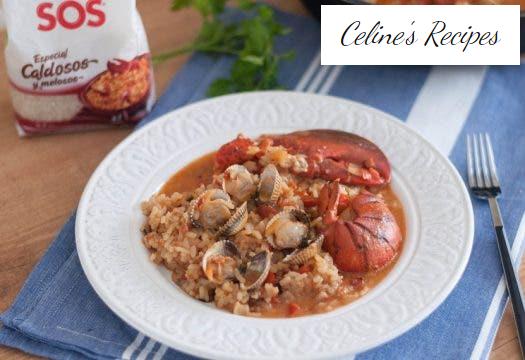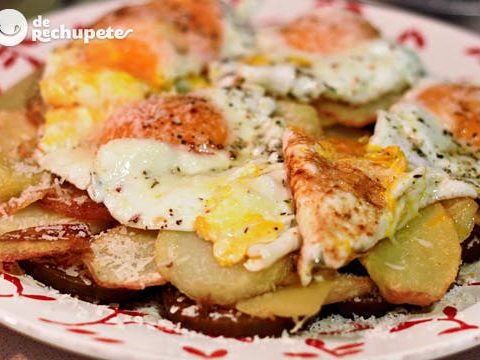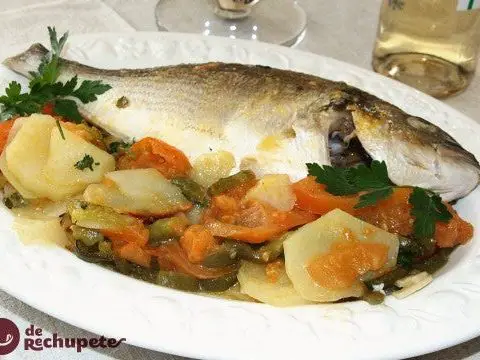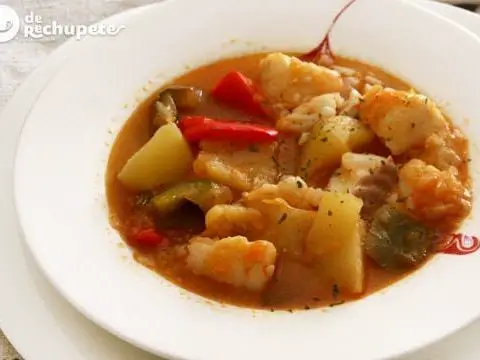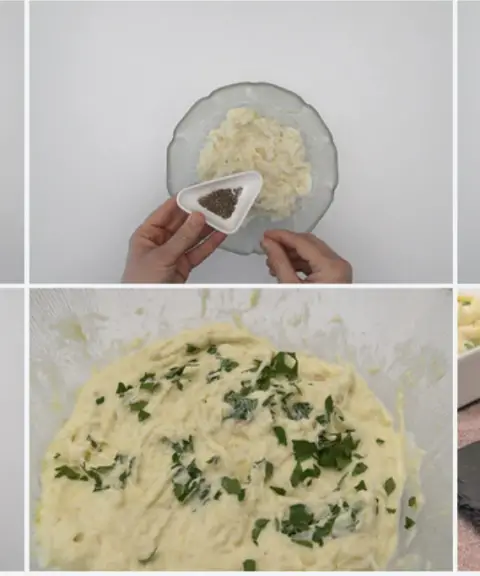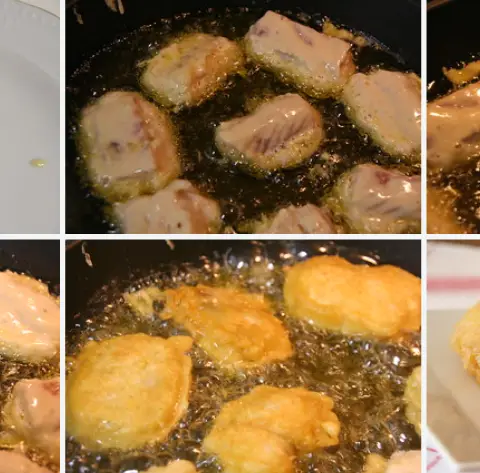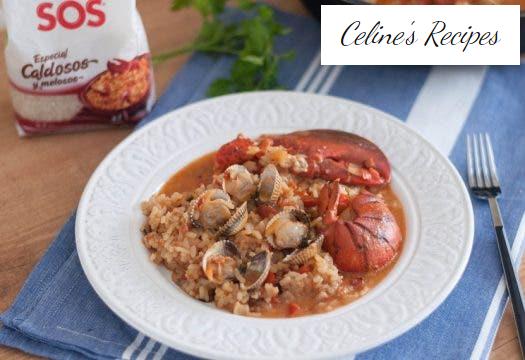
Info.
- Easy
- 60 minutes
- For 6 people
- € 14 / person
- 270kcal per 100g.
How to make rice with seafood. “Rice with mariñeiro”
For the rice that I present today, the most important thing is the rice and the broth. A good fumet that gives it flavor is everything.
If we do it right, and you already know that our fumet or fish broth always triumphs, this rice will be the protagonist of any great meal, dinner or family event.
For this type of “special” recipe, where I spend time and money, I don’t use broth broth. I know that many people do not have time or desire, that they solve a lot, but the truth is the flavor is not the same. So I recommend that you prepare the broth beforehand.
For this mariñeiro rice we have two protagonists of luxury, a big one, a lobster and some little friends, some cockles from Ría de Arousa.
Today’s objective is that you dare to cook this rice, do not think it is a complicated recipe, it is super simple. The key to success is in the chosen rice , in the flavor of the broth.
The rice is mellow, tasty, with a taste of the sea and seafood like few others. As it is a soupy rice , this time, the result is juicy and tasty. The rice with which we have prepared this rice is the SOS special broth rice that always gives us such good results.
Before cooking the recipe. How to cut lobster
Once we take the lobster out of its natural environment it begins to die slowly, so to keep it as long as possible alive it is necessary to cover it with a damp cloth, which we will change every 12 hours.
A lobster that we have bought alive can survive in the fridge for 3 to 4 days at a temperature of 5 degrees.
- If you are going to use live lobster, it is best to buy it the day before so that the bug suffers as little as possible.
- When buying it, make sure that the lobster is still alive and looking vital. That it does not present cuts or damages, that it has all its legs and its integral clamps, that the shell is hard and consistent.
- If the lobster we are going to prepare is alive, be careful as it will defend itself. Your clamps can be dangerous, although normally they come with elastic bands so that they cannot be opened, do not remove them until the end of the cut.
- Place the lobster on a non-slip board, always “belly up” with the tail against the cutting surface.
- The surface where we are going to cut it must allow us to take advantage of the juices that will be spilled during the cut, because this liquid is very tasty and will allow us to give a more intense flavor to our dish.
- Once we have the lobster fixed, we introduce the knife behind the end of the head and cut, separating the trunk from the tail, into two parts of similar size.
- Then we turn the lobster and cut the head into two symmetrical parts, to then cut the trunk into medium pieces, taking advantage of the carapace rings.
- We can also cut it into slices, starting with a clean cut on the head and then cut each ring on the trunk into slices. We reserve in a large bowl.
Before cooking. Cockles
On this occasion we added some cockles that were on sale, it is not a fundamental ingredient but it gives rice a little flavor.
- Like all molluscs, cockles must go through an expedition center or a treatment plant before being put on the market for consumption, but we still have to remove the sand that they usually bring so that it is not bothersome and does not spoil the recipe .
- It is convenient to have them about three hours before cooking them in a saucepan or large plastic container.
- We must add water, a good handful of coarse salt and change the water three or four times.
- If you are going to take them alone with a little lemon, prepare them by steaming. In this rice we will reserve them for the last 5-6 minutes of cooking the rice, more than enough to flavor the dish and that they are done.
- If any of them does not open, we will have to throw it away, like those that are broken. We reserve for the final process of the rice.
Preparation of rice with seafood
We can make rice more or less stocky. I personally like it with some broth but there are people who prefer it as a paella, I have seen rice dishes with lobster dry and broth.
Therefore, you can do it in a normal paella or, if you like more with broth, in a clay pot. As you see, because it also depends on the number of servings you are going to prepare.
- We choose a large casserole, if it is better clay or, as in this case, a paella.
- The quality point of the rice will be in the fumet or broth with which we are going to enrich the recipe. In several recipes I explain the step by step to achieve an almost perfect fumet .
- In this case I prepared it in an express pot, I added in addition to monkfish bones, shrimp heads and a lot of vegetables that my mother had in the fridge, and it was impressive. If you do not have time, you can use some ready-made broth (better that it is of quality) that they sell in supermarkets.
- Peel the garlic cloves and chop as best as possible. Chop the onions and red peppers very fine so that they melt in the cooking.
- It is important not to notice its texture but the flavor they give to rice. We reserve everything.
- We add the extra virgin olive oil to the paella. When the oil is hot, fry the vegetables about 10 minutes over medium heat, always stirring carefully.
- We toss the heads of the two lobsters (we add the tails later) and sauté with the vegetables. Season with salt and pepper to taste.
- Grate the tomato or remove the skin and chop very finely. When the previous vegetable is already poached we add it together with a teaspoon type of sweet paprika de la Vera (very little, just to give a little aroma) and stir everything slowly until reduced.
- It has to look like a sauce that is not very liquid but does not cling to the paella.
Rice and its cooking
- We toss the bomba rice and stir everything gently so that it is well impregnated with the stew and absorbs the flavor.
- We leave for 2 more minutes on medium heat.
- Once the rice has absorbed all the flavor of the stew we add the fish fumet (if possible hot) to the paella or casserole.
- For a semi-broth rice the exact measurements are 3 and a half parts of broth for each part or measure of rice. Even so, if we see that the rice is a little hard but the casserole is running out of enough liquid, we will gradually add more water until it is at its point.
- If you do not use rice bomb it does not need so much liquid, because other types absorb less, with 3 parts of broth for one of rice would be more than enough.
- The broth that you have is perfect for other recipes, save it or freeze it, it is liquid gold.
- We raise the temperature to the maximum until it begins to boil and then we lower it to half and add the saffron threads, which is done little by little (about 18-20 minutes for this type of rice).
Presentation of the Mariñeiro rice. Tasting
- In the last 5 minutes of cooking we add the remaining pieces of lobster and if you want the cockles (you can replace them with clams, chirlas or even mussels, they will give it more seafood flavor).
- If necessary, we rectify the amount of liquid with water (if possible hot to avoid cutting the cooking) and we are testing the point of salt and rice. If you need a pinch of salt, it’s time to add it.
- Do not be scared if when lobsters cook it acquires a characteristic red color, it happens in almost all crustaceans. It is a good sign and the point that tells us that the plate is almost done.
- We remove from the fire and let it rest only 2-3 minutes, we do not want it to pass us point.
- In addition, there must be some broth, and if we leave it for a long time in rest, the rice will continue to swell and absorb broth. To the plate directly and do not get burned.
I assure you that someday if you do, you will repeat the recipe, because it is simply yummy.
And above all, serve it with a good fresh Galician white wine.
Thanks to the valuable help of Eduardo Castro and my sister Nuria. Always there to help when needed. Impossible that something goes wrong with these pinches.
Be sure to enjoy all the recipes for fish and seafood that we have on the blog.
You can see all the photos of the step by step of this seafood rice in this album.
